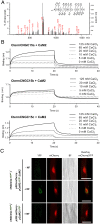Engineered CaM2 modulates nuclear calcium oscillation and enhances legume root nodule symbiosis
- PMID: 35324326
- PMCID: PMC9060481
- DOI: 10.1073/pnas.2200099119
Engineered CaM2 modulates nuclear calcium oscillation and enhances legume root nodule symbiosis
Abstract
SignificanceOscillations in intracellular calcium concentration play an essential role in the regulation of multiple cellular processes. In plants capable of root endosymbiosis with nitrogen-fixing bacteria and/or arbuscular mycorrhizal fungi, nuclear localized calcium oscillations are essential to transduce the microbial signal. Although the ion channels required to generate the nuclear localized calcium oscillations have been identified, their mechanisms of regulation are unknown. Here, we combined proteomics and engineering approaches to demonstrate that the calcium-bound form of the calmodulin 2 (CaM2) associates with CYCLIC NUCLEOTIDE GATED CHANNEL 15 (CNGC15s), closing the channels and providing the negative feedback to sustain the oscillatory mechanism. We further unraveled that the engineered CaM2 accelerates early endosymbioses and enhanced root nodule symbiosis but not arbuscular mycorrhization.
Keywords: calcium signaling; calmodulin; root legume symbiosis.
Conflict of interest statement
The authors declare no competing interest.
Figures





References
-
- Tilman D., Cassman K. G., Matson P. A., Naylor R., Polasky S., Agricultural sustainability and intensive production practices. Nature 418, 671–677 (2002). - PubMed
-
- Bozsoki Z., et al. , Ligand-recognizing motifs in plant LysM receptors are major determinants of specificity. Science 369, 663–670 (2020). - PubMed
-
- Carotenuto G., et al. , The rice LysM receptor-like kinase OsCERK1 is required for the perception of short-chain chitin oligomers in arbuscular mycorrhizal signaling. New Phytol. 214, 1440–1446 (2017). - PubMed
-
- Madsen E. B., et al. , A receptor kinase gene of the LysM type is involved in legume perception of rhizobial signals. Nature 425, 637–640 (2003). - PubMed
-
- Radutoiu S., et al. , Plant recognition of symbiotic bacteria requires two LysM receptor-like kinases. Nature 425, 585–592 (2003). - PubMed
MeSH terms
Substances
LinkOut - more resources
Full Text Sources
Other Literature Sources

